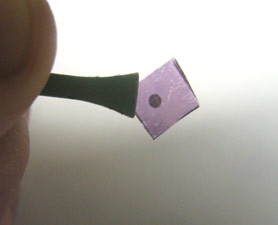Light Powered Circuit

The iPad has yet to hit store shelves, and yet the technology that powers Apple’s latest gadget may already be yesterday’s news.
For the first time, scientists have created a circuit that can power itself, as long as it’s left in a beam of sunshine. Created by scientists from the University of Pennsylvania, the world’s first photovoltaic circuit could eventually power a new line of consumer devices or even model the human brain.
Source: World’s First Light-Powered Circuit Create
“This as the potential to create a new generation of optical and electronic devices,” said Dawn Bonnell, a scientist from the University of Pennsylvania who co-authored a recent ACS Nano paper describing the research. “The touchscreen of your computer could act as both the electrical charger and the computer chip.”
Right now Bonnell and her colleagues can only coax minuscule amounts of electricity from their photovoltaic circuits, far too little to power consumer electrical devices. Those amounts could quickly skyrocket.
“We would have one amp with one volt in a sample the diameter of a human hair and an inch long,” said Bonnell. “If the efficiency scaled up without any additional limits.”
There are plenty of other ways Bonnell can squeeze more electricity from light. Right now only about 10 percent of the photovoltaic circuits on a glass side work. Increasing that number will boost the power output.
Yet another way to get more power is by turning their 2D structures into 3D structures. Stacking multiple layers of light-collecting and electricity-using circuits would also boost power.
The photovoltaic circuit developed by Bonnell and her colleagues is a scientific breakthrough, not a technological one. These new circuits will most likely never replace their silicon counterparts.
Photovoltaic circuits could be ideal for other applications, however, such as powering tiny robotic devices or running computer calculations at the speed of light.
Far into the future, these circuits could even be used to set up as artificial neural networks that could model the brain.
At their most basic, computers represent data as on or off, a “0” or a “1.” Using light instead of electrons, these photovoltaic circuits could store data from, say, one, two, three or four. Each number would correspond to a certain wavelength or color of light — red, green, blue and yellow, for example. To model the human nervous system, each color of light could correspond to a different neurotransmitter, say red for dopamine and blue for serotonin.
“This could open the door for many kinds of new devices,” agrees Lukas Novotny, a scientist at the Institute of Optics at the University of Rochester. Novotny notes that right now the circuit turns light into energy. He wonders if the circuit could turn energy into light, creating an entirely new class of lighting materials.
The potential applications of the technology are huge, but will take years to develop into any kind of practical equipment.

Leave a Reply
Want to join the discussion?Feel free to contribute!